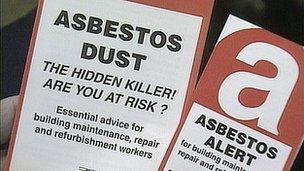Asbestos in schools 'a national scandal' - MPs
- Published

Efforts have been made to raise awareness in the construction industry
The presence of asbestos in most UK state schools constitutes a "national scandal", MPs and peers have said.
An all-party group is calling for a scheme to remove the material after studying estimates which suggest it was present in more than 75% of schools.
More than 140 teachers have died from the rare asbestos-related cancer mesothelioma in the past 10 years.
Education chiefs say it is unacceptable for schools to ignore guidance but that undamaged asbestos should be left.
Last year, the Department for Education (DfE) revealed that its "best estimate" was that more than three-quarters of schools contain asbestos.
The Parliamentary Group on Occupational Safety and Health's chairman, Jim Sheridan, said: "This is a national scandal.
"Urgent action is needed to prevent more pupils, teachers and other staff being exposed to this deadly killer dust.
"We need both far greater awareness of the risks that this material poses and a programme for its phased removal."
Dangerous fibres
The group's other recommendations include annually updating parents, teachers and staff about asbestos in their schools, and reinstating inspections into asbestos management.
Asbestos was used extensively as a building material from the 1950s until the mid-1980s, often in fireproofing and insulation.
But it becomes dangerous when disturbed. If inhaled, its fibres cause lung complaints such as the fatal mesothelioma and debilitating asbestosis.
Researchers in the US found that for every death of a teacher from asbestos-related diseases, nine children will die.
Children are more vulnerable because they have longer than adults to develop diseases related to the material.
According to the Health and Safety Executive (HSE), inhaling asbestos is the single greatest cause of work-related deaths in the UK - accounting for 4,000 deaths per year.
A DfE spokesman said the welfare of pupils and staff was paramount.
"It is unacceptable for any school not to comply with the strict statutory asbestos guidance - no ifs or buts," he said.
But he added: "HSE's expert advice is based on the best current evidence.
"It is absolutely clear that if asbestos is not disturbed or damaged, then it is safer to leave it in situ, with strong systems in place to contain and monitor it."